Family : Scaridae

Text © Giuseppe Mazza

English translation by Mario Beltramini
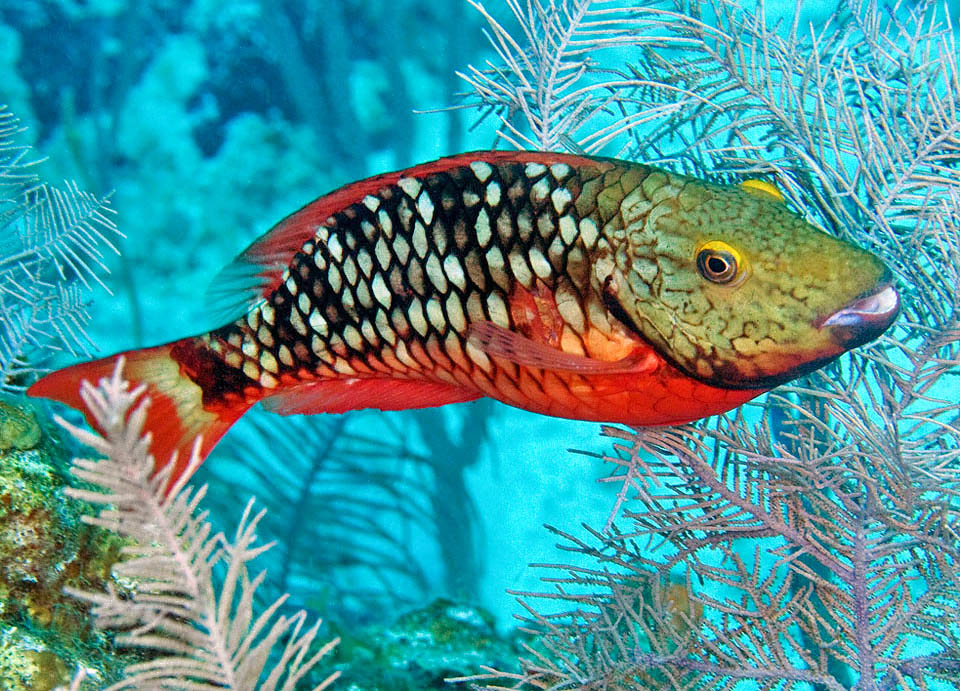
Rare case in the parrotfishes, the females of Sparisoma viride, frequent in the west Atlantic tropical waters, are no less conspicuous than the males © Paddy Ryan
Belonging to the class of the Actinopterygii, the ray-finned fishes, and to the order of the Perciformes, the parrotfishes are placed by some in the family of the Scaridae that nowadays counts about ten genera and one hundred species.
After other taxonomists, molecular studies in hands, these fishes should be instead placed in the Scarinae as subfamily of the Labridae, a much wider group that boasts already, without counting the parrotfishes, 70 genera and 559 species.
In both cases these are fishes swimming with the pectoral fins and are surprising for their bright liveries changing look and sex offhandedly often making fun of the taxonomists.
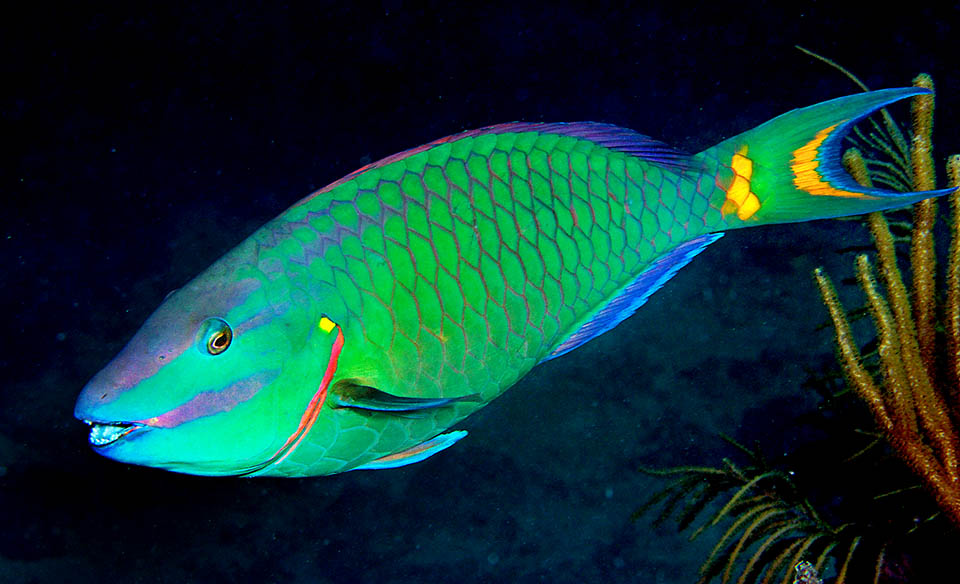
However the species given name has privileged the green livery of the male in terminal phase, here at the peak of its splendour © Keoki Stender
But, on the other hand, the parrotfishes are not carnivores like the wrasses and have their teeth fused together forming two maxillary plates. They are well characterized and homogeneous of herbivores that produce sand, even if each species has its own particularities.
There are those who hit the corals with their heads, like Bolbometopon muricatum to then swallow their fragments and enjoy them long time in the mouth, grinding them like crunchies, those who clean up the reef scratching the encrusting algae like the Scarus psittacus, those who take off, cutting them sharply like scissors, the foliage of the benthic algae like Calotomus carolinus and those having a strong propensity for the zooxanthellae, the microscopic symbiont algae present in the polyps of the coral, that catch them on the fly, before they retract, with a good part of the support.
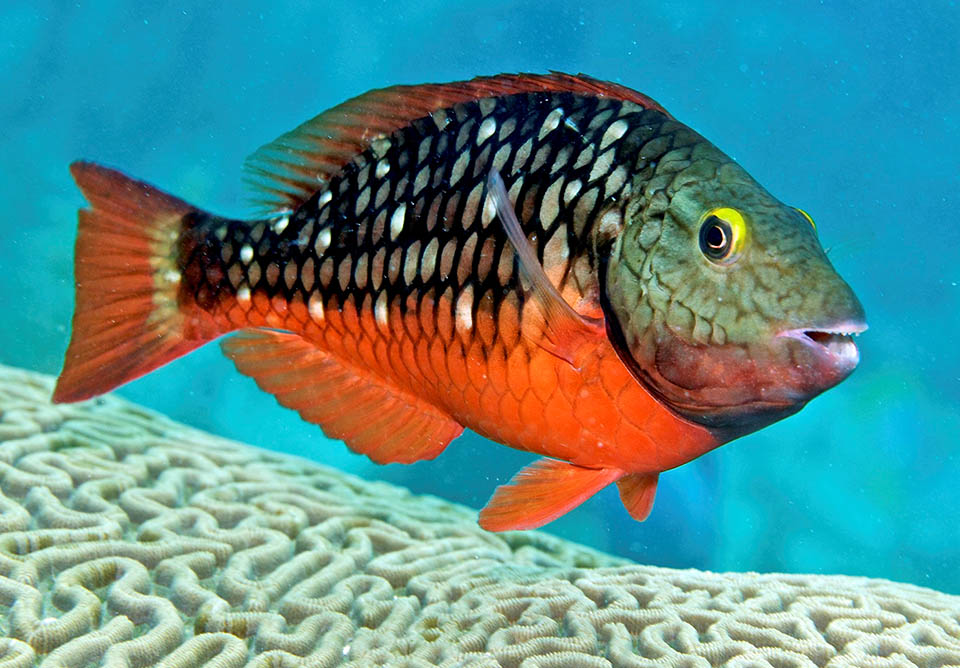
In this initial phase the males are equal to females but the 4-5% is already able to reproduce with this livery, maybe stealthily, mixed with the females of a harem © Allison & Carlos Estape
One might say that Sparisoma viride (Bonnaterre, 1788) is a “fine mouth” loving the soft algae and proving rather selective in the choice, with a predilection for those belonging to the genus Dictyota, whilst, among the madrepores, its preferences go to the polyps of Porites porites and of Montastraea annularis.
It is called Stoplight parrotfish because of the small yellow dot that appears on the central edge of the operculum in the adult males in terminal livery, whilst the genus Sparisoma comes from the Latin “sparus” = javelin, due to the profile of the fish like the tip of a spear, and from the old Greek “σῶμα” (soma) that means body. It would therefore be a fish evoking the tip of a spear.
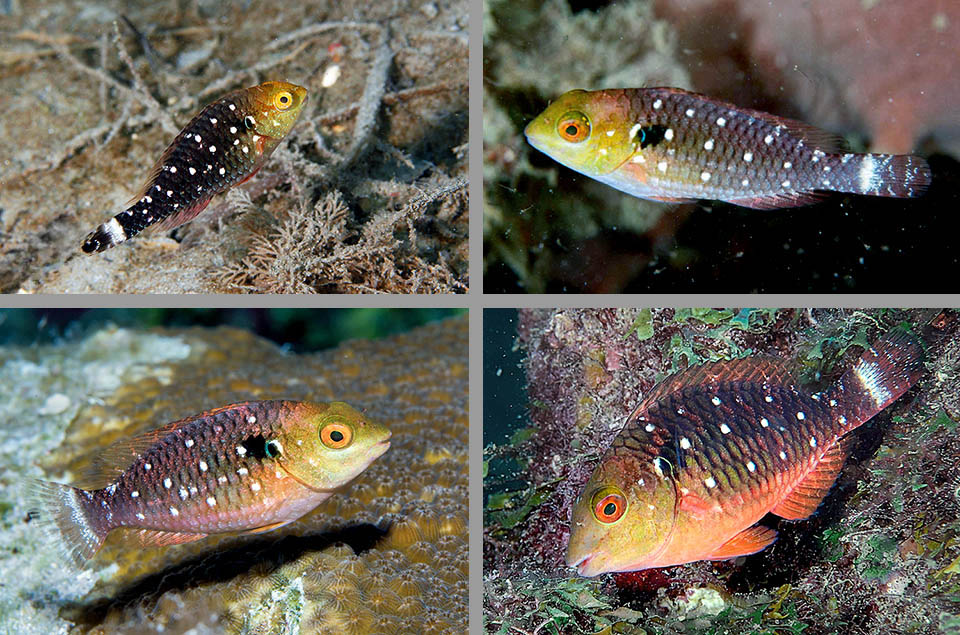
Here the first growth phases with the typical mimetic dotting. Above © Kevin Bryant e © Rick Stuart-Smith, Reef Life Survey. Below © Brian Cole and © Kevin Bryant
But in this name may also be found an easy reference to the Gilthead seabream, classified with analogous root by Linnaeus as (Sparus aurata) that, however, belongs to the family of the Sparidae.
One could therefore also simply conclude that it is a fish with the body of a Sparus or that it is a Scaridae resembling a Sparidae.
Conversely, the specific term viride reminds us, much more simply, that it is a green fish. This, of course, in the terminal male livery, because Sparisoma viride is a protogynous hermaphrodite species.
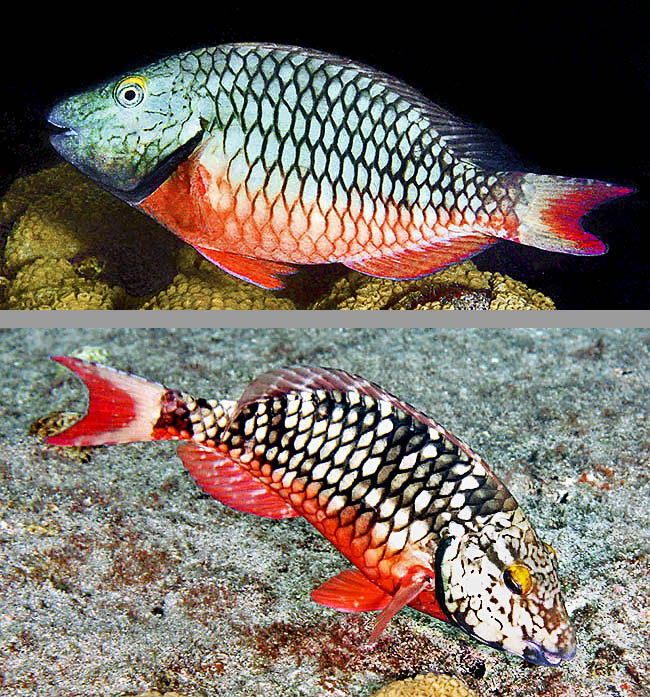
Then the big scales, initially white with the dark brown edge in the two upper thirds of the body, can take on almost black shades whilst the belly and the fins get coloured bright red and the head gray brown © Kevin Bryant
At a certain point, in fact, the females transform into males and in the first phase, the female or of the young males one, the colour catching the eye is not surely the green but the bright red of the fins and of the belly.
Zoogeography
Sparisoma viride lives in the western Atlantic tropical waters.
Starting from the Bermuda Islands, it is a species common in the south of Florida, the Gulf of Mexico, the Antilles and the Caribbean up to the northern part of Brazil.
Ecology-Habitat
The adults mainly go swimming in the madreporic environments, rich of ravines where they can hide during the night, whilst the young grow often at the shelter of the foliage in the seagrass meadows.
Benthopelagic diurnal species, the Stoplight parrotfish usually swims between 3 and 50 m of depth with a marked preference for the sites little frequented by man, so much so that along the coasts can be found only fishes of modest size, about 4 years old, whilst in the offshore reefs they may reach even the 8 years of age with obviously larger dimensions.
It is a fish devoted to the meal for most of the day. It moves a lot, scraping or nibbling only the best bites, at times alone or in pairs, but often in small schools formed by one terminal male and some female.
The most frequented areas are those exposed to the waves, where on the dead parts of the madrepores grow, abundant, the algae it often swallows together with the substratum producing coral sand.
As usual among scarids, these fishes grind for a long time what they pick up with their solid pharyngeal teeth and the waste, after a long intestinal journey, is the candid sand that contributes to the charm of many exotic beaches.
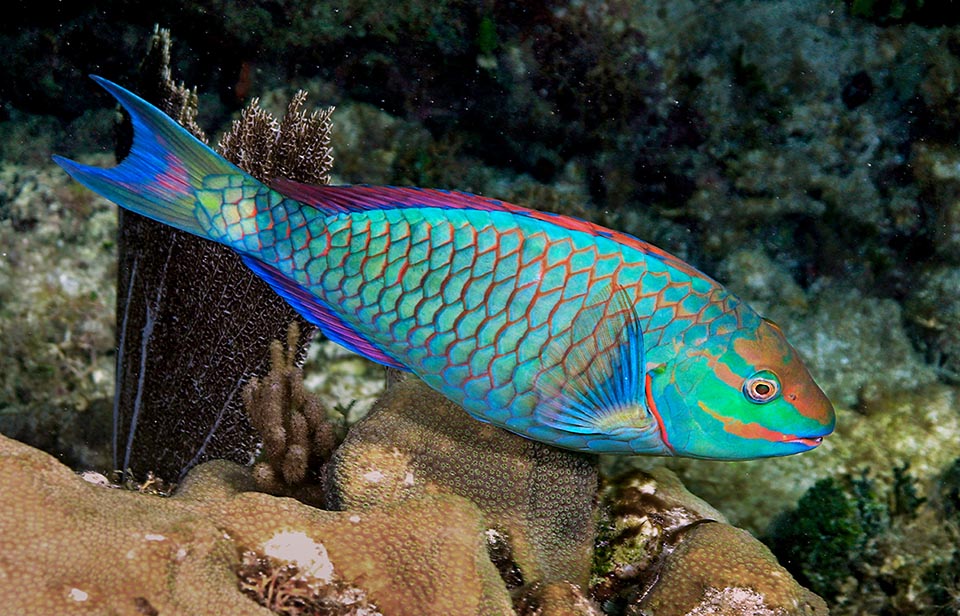
Rare transition image from the initial female phase to the male livery. The testicles are already operational because they mature before the livery © Keoki Stender
Morphophysiology
Sparisoma viride may reach 64 cm in length but the usual size is about 38 cm, and it is interesting to note that unlike other parrotfishes, the males are not bigger than the females. They change livery during the terminal phase but the maximum measures keep unchanged.
Anatomically, the long dorsal fin has 9 spiny rays and 10 soft, the anal, shorter, 3 spiny rays and 9 unarmed. The pectoral ones have 12 soft rays, the pelvic ones are absolutely normal and the caudal is much longer on the sides in the old males.
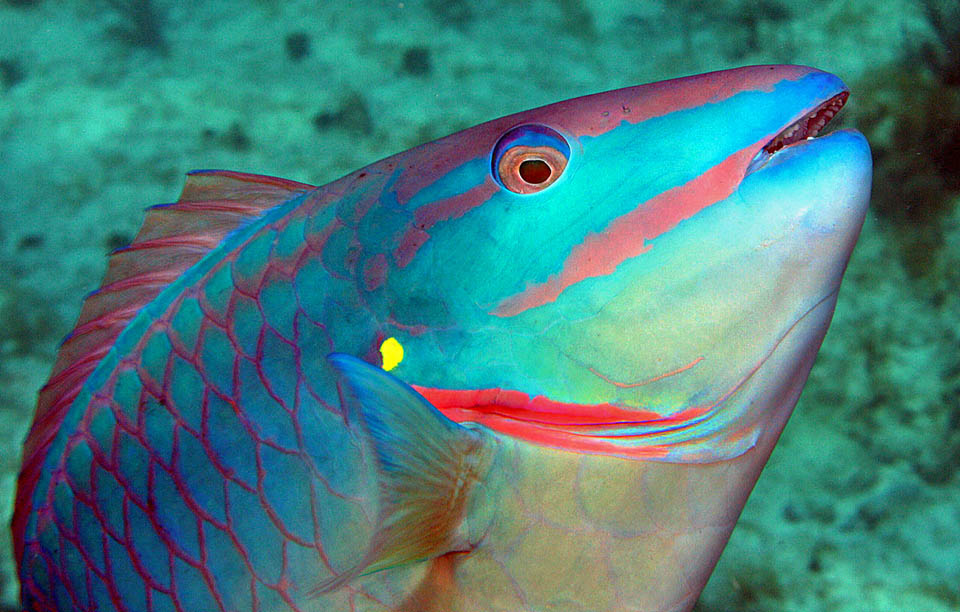
The male livery completion is marked by the appearance of a luminous yellow spot on upper edge of operculum, from where the name of Stoplight parrotfish © Kevin Bryant
The two solid maxillary plates are poorly visible, because they are covered mostly by the gums. At the apex they are serrated interlocking, to better cut the algae, but they cannot be noted at the base of the small canines, as for instance occurs in Scarus prasiognathos and in Scarus flavipectoralis.
After the juvenile stage, characterized by a mimetic livery, dark and then reddish, with 3 rows of white spots and a vertical white stripe at the base of the caudal fin, we reach, when about 16 cm, to the phase, called initial, where the males have the same livery of the females. The head tends to brown, whilst the big scales of the two upper thirds of the body have the clear centre and the dark brown edge gradually fading in the bright red of the belly and of the fins.
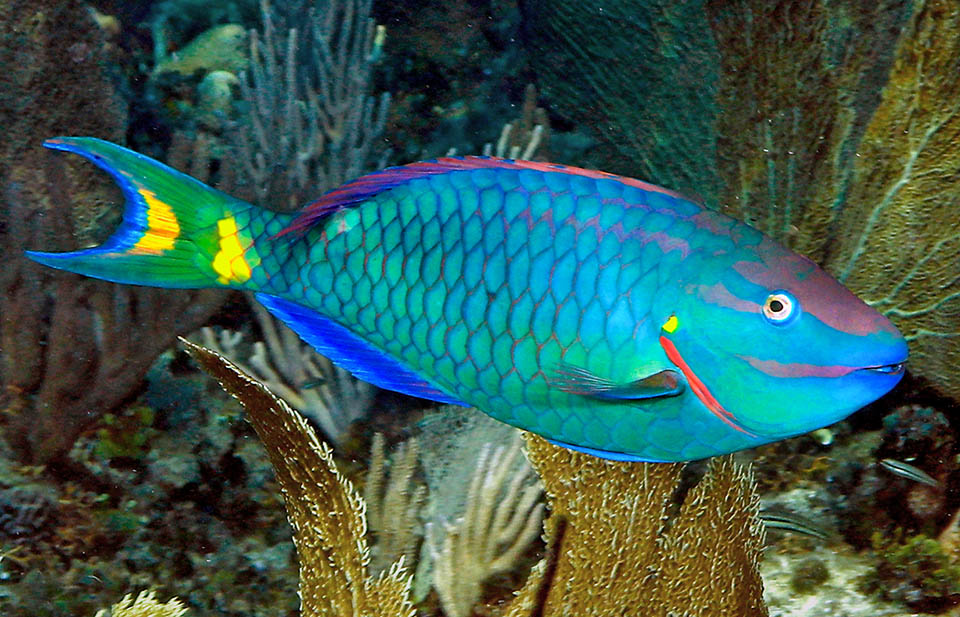
Spectacular colour palette of a male in terminal phase. Among turquoise, blue and green changing shades, we note 3 dark pink bands in the upper part of the head, a showy red band on the edge and the membrane of the operculum, a vertical yellow band at the end of the peduncle and a yellow crescent on the caudal fin © Keoki Stender
In this stage, at times, the centre of some scales gets very dark creating a mimetic pattern that in comparison with the rest seems sometimes almost white and black.
The females mature whan about 17-25 cm and do not change the colours any more, whilst the males, even if in the 4-5 % of the cases are already able to reproduce with these dimensions and with female livery, take on completely different colours.
In the terminal phase, in fact, they are of bright green colour with a band of yellow scales at the end of the caudal peduncle and a similarly coloured crescent on the adjacent fin that extends on the sides.
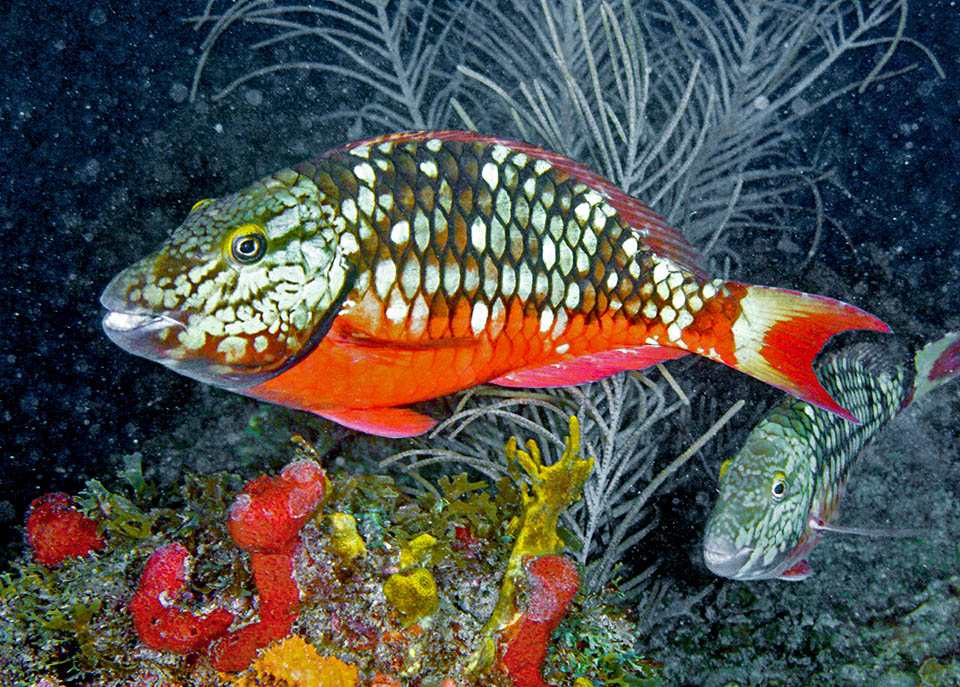
Also this female is no less pictorial. To note that, unlike what happens usually among the scarids, the maximum reached length is the same in the two sexes © Kevin Bryant
The head shows in the upper part three pinkish bands and the famous yellow small spot, a stoplight between green and red, that they proudly bear on the edge of the operculum as a distinctive and discreet sign of a well-filled life, like the reduced version of the nightly honour the humans display with ostensible discretion on the lapel of the jacket.
Finally, close to this on the edge of the operculum and on the opercular membrana, we note a showy red conspicuous red diagonal.
Furthermore, we have to add; as is the case for many fishes and particularly in the world of the scarids, both males and females may act on the chromatophores modifying instantly, within certain limits, their livery.
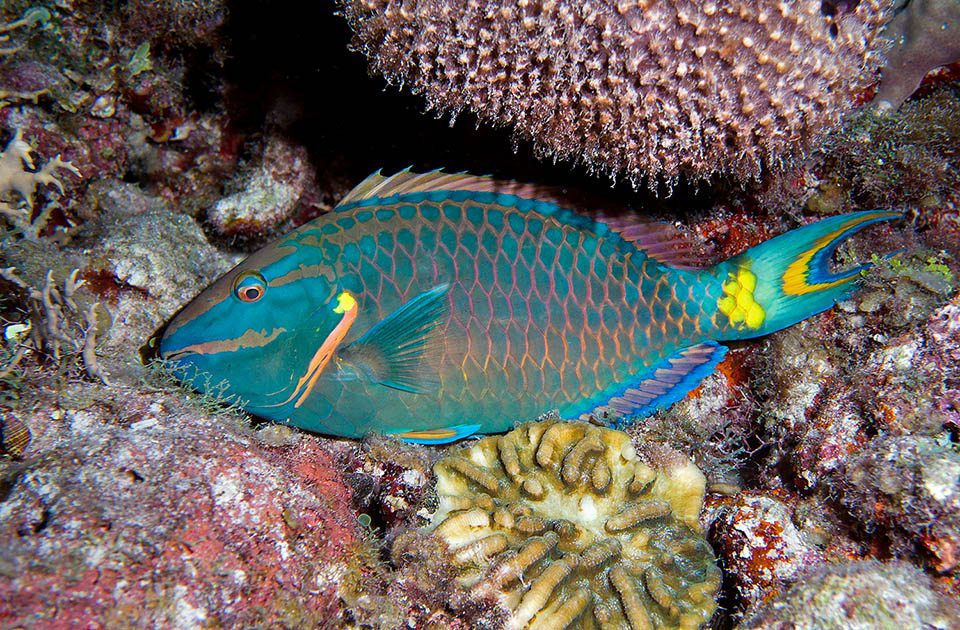
Terminal male in night livery. It has toned down all colours but the mimetic edge of the scales, but does not renounce to the characteristic yellow speck and to the luminous yellow scales present on the caudal peduncle. Probably they simulate in the dark a fake eye to direct predators to a non-vital organ while the fish runs away © Jeff Mitton
A master of the group is undoubtedly Calotomus carolinus that reveals itself since its early age a skilled transformer with terminal males where the background colour changes with ease from turquoise to green, to blue or to the reddish brown. They keep unchanged only the starry drawing around the eyes, their “command mark”, present also in the mimetic pajama they wear when they go to sleep to escape from the eye of the predators.
Similarly, also the males of Sparisoma viride do not abandon during the night, even if softening the colours, their yellow ornamentation on the edge of the operculum and their yellow scales present on the caudal peduncle that probably simulate in the dark a fake eye in order to direct the predators towards a non-vital organ while the fish runs away.
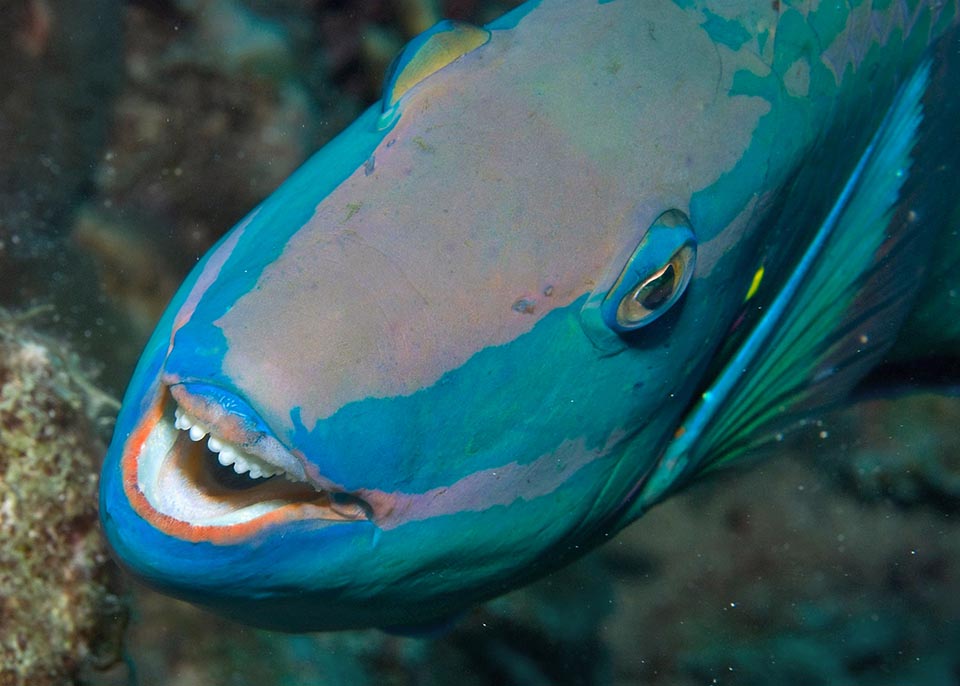
Here smiling upon waking. The maxillary plates of Sparisoma viride are toothed at the margin for better cutting the algae © Dan Hershman
Ethology-Reproductive Biology
Sparisoma viride reproduces during the whole year but with greater intensity at the beginning of spring.
A recent research has shown that in this period the fished females, regardless of size, were ready to spawn even 60.000 eggs.
The terminal males become more territorial than usual, because a great territory means practically more females. They fecundate them in turn, but it is not excluded that some male with female livery may add stealthily its own gametes.
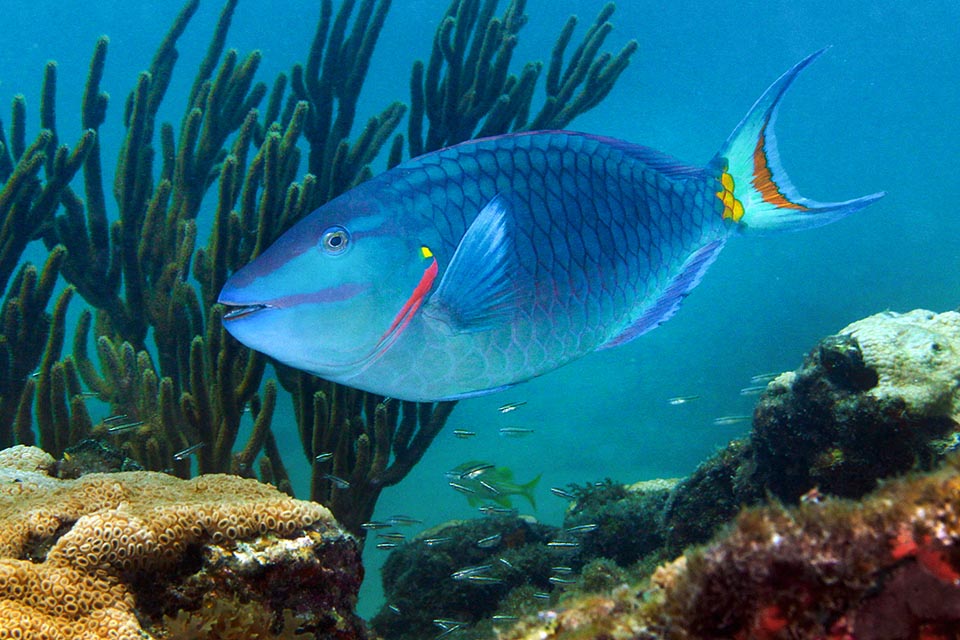
Impressive grazing specimen. It nourishes biting off, with a predilection for the algae of the genus Dictyota and the polyps of Porites porites and of Montastraea annularis © Kevin Bryant
The eggs, thanks to an oily bubble, are floating and hatch after 26 hours from the fecundation.
The larvae, pelagic too, measure 1,4 mm. They float upside down, until the oily bubble lasts, and grow up carried by the currents.
The Spotlight parrotfish is locally fished for local consumption though cases of ciguatera do occur, a serious food poisoning linked to particular poisonous species that may belong to their diet.
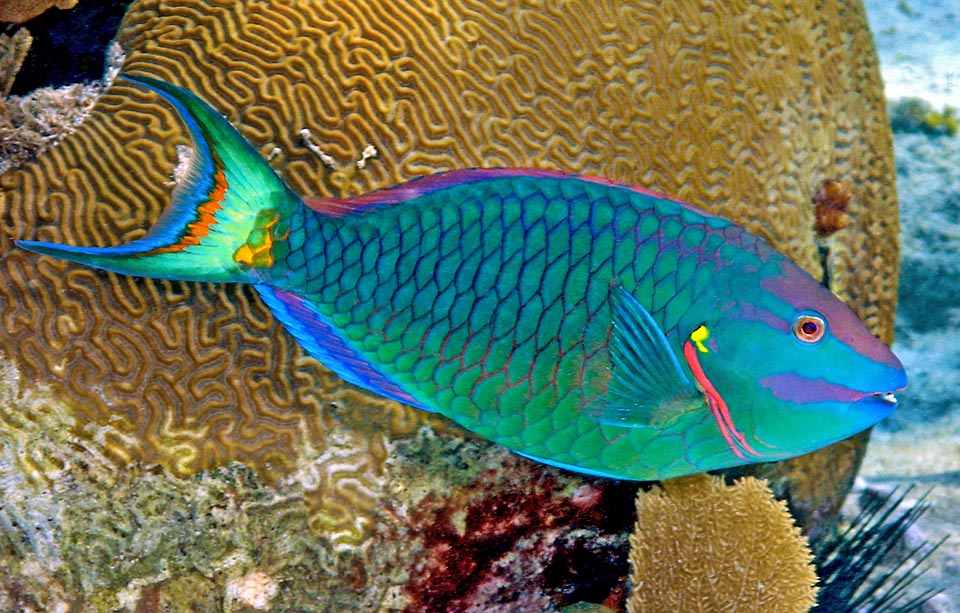
In the reproductive time the terminal males become more territorial than usual. In fact a vast domain means more females to fecundate in turn when ready. They lay even 60.000 eggs each, regardless of females’ size. An oily bubble makes them float and in this way they are entrusted to the currents. The larvae, pelagic too, measure 1,4 mm © Keoki Stender
It is not an endangered species.
The resilience of Sparisoma viride is relatively good, with a possible doubling of the populations decimated by the events in 1,4-4,4 years and the fishing vulnerability index is presently modest, marking 31 on a scale of 100. It therefore appears as “LC, Least Concern” in the Red List of endangered species.
Synonyms
Scarus viridis Bonnaterre, 1788.
→ For general information about FISH please click here.
→ For general information about BONY FISH please click here
→ For general information about CARTILAGINOUS FISH please click here.
→ To appreciate the BIODIVERSITY of BONY FISH please click here.
→ To appreciate the BIODIVERSITY of CARTILAGINOUS FISH please click here.
